小波与滤波器组:Wavelets and Filter Banks(PPT-17)
合集下载
小波与滤波器组:Wavelets and Filter Banks(PPT-15)
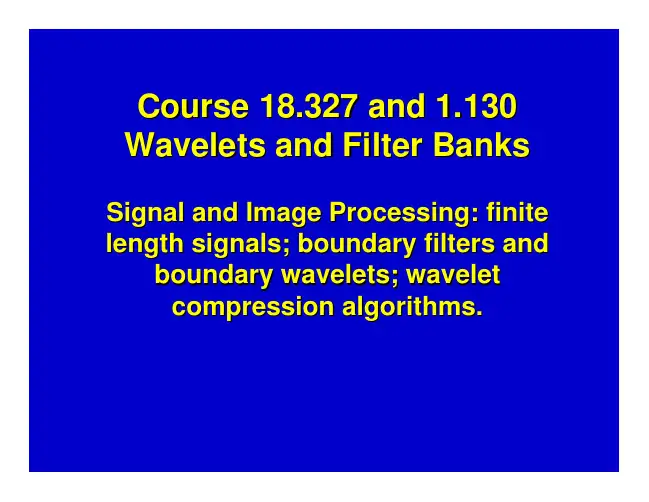
0 1
12
Then, x–1 = [1 -1 1 -1]
a b = [1 -1 1 -1] A–1 c d
x0 x1 x2 x3
PDE
f(x) = ∑ ckφ(x – k)
k p-1 i=0
Assume f(x) has polynomial behavior near boundaries ∑ αixi = f(x) = ∑ ckφ(x – k)
Symmetric extension of finite-length signal X(ω) = B(ω)e-iωβ
10
The output: Y(ω) = H(ω)X(ω) W W H H W H H W W H W H
W = whole-point symmetry H = half-point symmetry
n
x[n]e-i N n Want real-valued results.
14
2πk
complex-valued
0
N-1 n=0
1 m
2N-1
N-1
N
m
2N-1
2N
DFT of this extended signal: ∑ x[n]e
2πk –i 2N n
+ ∑
N-1
LOOMOON
n=N
2πk
k
{φ ( - k)} orthonormal ∑ αi ∫ φ(x – k)xidx = ck
i=0 p-1
LOMON
ik
13
0 1 m p-1 0 0 0 0 1 o 1 2 1 1 m
α0 α1 o αp-1 =
c0 c1 o cp-1
【小波与滤波器组讲义-英文版】精品讲义-Wavelets and Filter Banks14
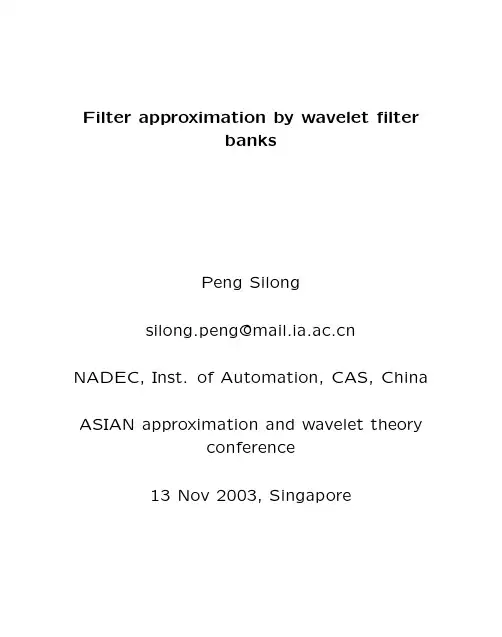
E.g., construct FIR filter approximating a ideal low-pass filter ( IIR), such as Equiripple method, Weighted least squares method (eigenfilters) and various window methods.
The answer is YES
Here we only consider approximating a given filter with orthogonal wavelet filters.
Problem:
Given: a filter H(ω)( low-pass or high-pass).
[6] A. Kirac and P. P. Vaidyanathan,(1998) ”On existence of FIR principal component filter banks”
[7] B. Xuan and R. H. Bamberger, (1996) ”2D factorable FIR principal component filter banks”
Pass-band, Stop-band, phase, ripples, etc
Motivation(2):
Filters have been used long long before wavelet appears. Many useful filters are using even now and in the future, they have good physical properties.
[2] M. K. Tsatsanis and G. B. Giannakis,(1995) ”Principal component filter banks for optimal multiresolution analysis”
The answer is YES
Here we only consider approximating a given filter with orthogonal wavelet filters.
Problem:
Given: a filter H(ω)( low-pass or high-pass).
[6] A. Kirac and P. P. Vaidyanathan,(1998) ”On existence of FIR principal component filter banks”
[7] B. Xuan and R. H. Bamberger, (1996) ”2D factorable FIR principal component filter banks”
Pass-band, Stop-band, phase, ripples, etc
Motivation(2):
Filters have been used long long before wavelet appears. Many useful filters are using even now and in the future, they have good physical properties.
[2] M. K. Tsatsanis and G. B. Giannakis,(1995) ”Principal component filter banks for optimal multiresolution analysis”
小波变换原理与应用PPT课件
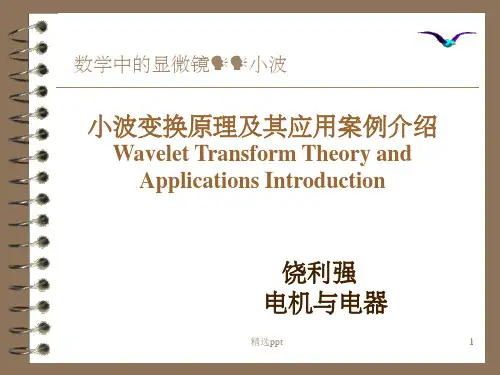
用傅立叶变换提取信号的频谱需要利用信号的全 部时域信息。
傅立叶变换没有反映出随着时间的变化信号频率 成分的变化情况。
傅立叶变换的积分作用平滑了非平稳信号的突变 成分。
由于上述原因,必须进一步改进,克服上述不足
,这就导致了小波分析。精选ppt
7
2.小波变换与傅里叶变换的比较
(1)克服第一个不足:小波系数不仅像傅立叶系 数那样,是随频率不同而变化的,而且对于同一个频 率指标j, 在不同时刻 k,小波系数也是不同的。
(0) (x)dx0
精选ppt
10
3.小波变换的基本原理与性质
信号的信息表示
➢ 时域表示:信号随时间变化的规律,信息包括均值、 方差、峰度以及峭陡等,更精细的表示就是概率密度 分布(工程上常常采用其分布参数)
➢ 频域表示:信号在各个频率上的能量分布,信息为频 率和谱值(频谱或功率谱),为了精确恢复原信号, 需要加上相位信息(相位谱),典型的工具为FT
与信号的初始段进行比较 ; ➢ 通过CWT的计算公式计算小波系数(反映了当前尺度
下的小波与所对应的信号段的相似程度); ➢ 改变平移因子,使小波沿时间轴位移,重复上述两个
步骤完成一次分析; ➢ 增加尺度因子,重复上述三个步骤进行第二次分析; ➢ 循环执行上述四个步骤,直到满足分析要求为止。
精选ppt
A x ( t)2 x ( t), m ,n ( t) 2 B x ( t)2 A ,B R
m ,n
x(t) Cm,n m,n(t) nZ
精选ppt
29
3.小波变换的基本原理与性质
正交小波变换与多分辨分析
多分辨分析也称为多尺度分析,是建立在函数空间概念上的理论 。它构造了一组正交基,使得尺度空间与小波空间相互正交。随 着尺度由大到小的变化,可在各尺度上由粗及精地观察目标。这 就是多分辨率分析的思想。在离散小波框架下,小波系数在时间尺度空间域上仍然具有冗余性,在数值计算或数据压缩等方面仍 然希望这种冗余度尽可能的小。在小波变换发展过程中, Stromberg、Meyer、Lemarie、Battle和Daubechies等先后成功的构 造了不同形式的小波基函数的基础上,是Meyer和Mallat将小波基 函数的构造纳入到了一个统一的框架中,形成了多分辨分析理论 。多分辨率分析理论不但将在那时之前的所有正交小波基的构造 统一了起来,而且为此后的小波基的构造设定了框架。
【小波与滤波器组讲义-英文版】精品讲义-Wavelets and Filter Banks7
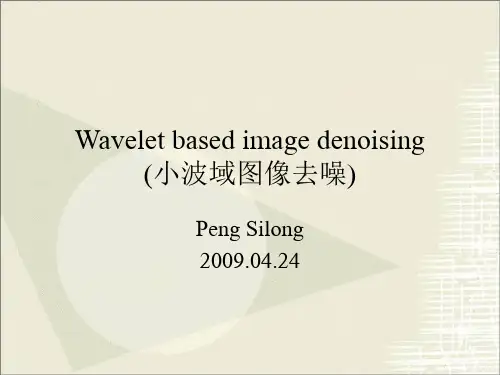
模型参数的快速估计
小波域HMT模型参数的快速 估计及其在图像降噪中的应用(六)
小波域HMT模型参数的快速估计
小波系数的分类
模型参数的快速估计
模型参数的快速估计
• 节点的状态概率 • 节点的状态转移概率 • 节点的方差
小波域HMT模型参数的快速 估计及其在图像降噪中的应用(七)
Gibbs效应的消除
小波域HMT模型参数的快速 估计及其在图像降噪中的应用(十一)
实验结果(PSNR:20.0107 28.2667)
小波域HMT模型参数的快速 估计及其在图像降噪中的应用(十二)
实验结果分析(PSNR:19.9862 25.3904)
小波域HMT模型参数的快速 估计及其在图像降噪中的应用(十三)
基于HMT模型的降噪算法
wˆ ( yi ) E wi yi , θ
m
P(Si
m
yi
,
θ
)
2 i,m
y
i
2 n
2 i,m
2 n
i,m
小波域HMT模型参数的快速 估计及其在图像降噪中的应用(六)
小波域HMT模型参数的快速估计
小波系数的分类
模型参数的快速估计
• 阈值选取
小波系数的分类
• 阈值分类
Wavelet domain method
y xn take wavelet transform both sides: Y X N, where Y , X , and N denote the wavelet transform of y, x, n respectively. Generally, people assume that the elements in Y and X are independent. Yi Xi Ni , where index i is the position of coefficient. coefficients of y, x, and n respectively. Bayesian framework in wavelet domain:
小波基础知识 PPT课件

设T : X
军事电子对抗与武器的智能化;计算机分 类与识别;音乐与语言的人工合成;医学 成像与诊断;地震勘探数据处理;大型机 械的故障诊断等方面;例如,在数学方面, 它已用于数值分析、构造快速数值方法、 曲线曲面构造、微分方程求解、控制论等。 在信号分析方面的滤波、去噪声、压缩、 传递等。在图象处理方面的图象压缩、分 类、识别与诊断,去污等。在医学成像方 面的减少B超、CT、核磁共振成像的时间, 提高分辨率等。
2
2
3
V,ej
2
v2
2
j 1
3 2
v1
1 2
v2
3 2
v1
1 2
v2
3 2
[
v1
2
v2
2]
3 2
V
定义、定理及证明
1. (巴拿赫)Banach空间与Hibert(西耳伯特) 空间
由于F(0) = 0,故 =0
2. 线性算子与同构
我们只考虑可分的Hilbert空间。
1986年著名数学家Y.Meyer偶然构造出一个真正的 小波基,并与S.Mallat合作建立了构造小波基的 同样方法及其多尺度分析之后,小波分析才开始 蓬勃发展起来,其中比利时女数学家 I.Daubechies撰写的《小波十讲(Ten Lectures on Wavelets)》对小波的普及起了重要的推动作 用。它与Fourier变换、窗口Fourier变换(Gabor 变换)相比,这是一个时间和频率的局域变换, 因而能有效的从信号中提取信息,通过伸缩和平 移等运算功能对函数或信号进行多尺度细化分析 (Multiscale Analysis),解决了Fourier变换 不能解决的许多困难问题,从而小波变化被誉为 “数学显微镜”,它是调和分析发展史上里程碑 式的进展。
小波与滤波器组:Wavelets and Filter Banks(PPT-4)
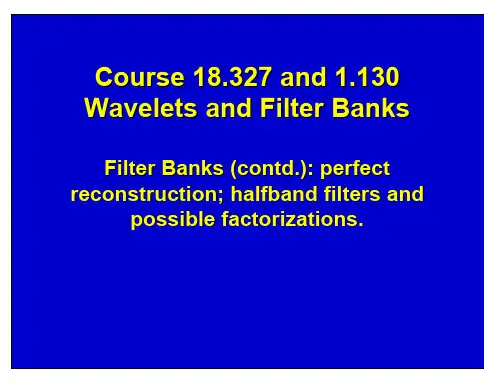
Example: Product filter of degree 6 P0(z) = P0(z) 1 16
(-1 + 9z-2 + 16z-3 + 9z-4 - z-6)
P0(- z) = 2z-3
Expect perfect reconstruction with a 3 sample delay Centered form: P(z) = z3P0(z) = P(z) + P(- z) = 2
i(ω h[n] linear phase A( ω)e–i(ω α + θ)
real
delays all frequencies by α samples
0 if symmetric π if antisymmetric 2
Linear phase may not necessarily be the best choice for audio applications due to preringing effects.
4 n 0 2 y[n] 4 n 0 2
16
x[n]
ii. Linear phase factorization e.g. 2/6, 5/3 Symmetric (or antisymmetric) filters are desirable for many applications, such as image processing. All frequencies in the signal are delayed by the same amount i.e. there is no phase distortion.
2nd order -1 2-√3
2nd order -1 2 + √3
(-1 + 9z-2 + 16z-3 + 9z-4 - z-6)
P0(- z) = 2z-3
Expect perfect reconstruction with a 3 sample delay Centered form: P(z) = z3P0(z) = P(z) + P(- z) = 2
i(ω h[n] linear phase A( ω)e–i(ω α + θ)
real
delays all frequencies by α samples
0 if symmetric π if antisymmetric 2
Linear phase may not necessarily be the best choice for audio applications due to preringing effects.
4 n 0 2 y[n] 4 n 0 2
16
x[n]
ii. Linear phase factorization e.g. 2/6, 5/3 Symmetric (or antisymmetric) filters are desirable for many applications, such as image processing. All frequencies in the signal are delayed by the same amount i.e. there is no phase distortion.
2nd order -1 2-√3
2nd order -1 2 + √3
【小波与滤波器组讲义-英文版】精品讲义-Wavelets and Filter Banks16
0.5 0
-0.5 -1
-1.5
10
20
30
40
50
60
70
80
90 100 110 120
residue
1.5 1
0.5 0
-0.5 -1
-1.5
10
20
30
40
50
60
70
80
90 100 110 120
IMF 1; iteration 1
1.5 1
0.5 0
-0.5 -1
-1.5
10
20
30
70
80
90 100 110 120
IMF 1; iteration 2 1.5
1
0.5
0
-0.5
-1
-1.5
10
20
30
40
50
60
70
80
90 100 110 120
residue
1 0.5
0 -0.5
-1
10
20
30
40
50
60
70
80
90 100 110 120
IMF 1; iteration 3
90 100 110 120
residue 1.5
1
0.5
0
-0.5
-1
-1.5
10
20
30
40
50
60
70
80
90 100 110 120
IMF 1; iteration 2 1.5
1
0.5
0
-0.5
-1
-1.5
10
20
-0.5 -1
-1.5
10
20
30
40
50
60
70
80
90 100 110 120
residue
1.5 1
0.5 0
-0.5 -1
-1.5
10
20
30
40
50
60
70
80
90 100 110 120
IMF 1; iteration 1
1.5 1
0.5 0
-0.5 -1
-1.5
10
20
30
70
80
90 100 110 120
IMF 1; iteration 2 1.5
1
0.5
0
-0.5
-1
-1.5
10
20
30
40
50
60
70
80
90 100 110 120
residue
1 0.5
0 -0.5
-1
10
20
30
40
50
60
70
80
90 100 110 120
IMF 1; iteration 3
90 100 110 120
residue 1.5
1
0.5
0
-0.5
-1
-1.5
10
20
30
40
50
60
70
80
90 100 110 120
IMF 1; iteration 2 1.5
1
0.5
0
-0.5
-1
-1.5
10
20
小波与滤波器组:Wavelets and Filter Banks(PPT-9)
N
φ(t) is called a scaling function The refinement equation couples the representations of a continuous-time function at two time scales. The continuous-time function is determined by a discretetime filter, h0[n]! For the above (Haar) example: h0[0] = h0[1] = (a lowpass filter)
j,k ∞
wjk(t) = 2j/2 w(2jt – k)
13
Multiresolution Analysis
Key ingredients: 1. A sequence of embedded subspaces: {0} … V-1 V0 V1 … Vj Vj+1 … L2() L2() = all functions with finite energy ∞ = {(t): ∫ (t) 2 dt < ∞} Hilbert -∞ space Requirements: Completeness as j → ∞ . If (t) belongs to L2() and j(t) is the portion of (t) that lies in Vj, then lim∞ j(t) = (t) j→
6
Some observations for Haar scaling function and wavelet 1. Orthogonality of integer shifts (translates): 1 φ(t) 1 φ(t - 1)
φ(t) is called a scaling function The refinement equation couples the representations of a continuous-time function at two time scales. The continuous-time function is determined by a discretetime filter, h0[n]! For the above (Haar) example: h0[0] = h0[1] = (a lowpass filter)
j,k ∞
wjk(t) = 2j/2 w(2jt – k)
13
Multiresolution Analysis
Key ingredients: 1. A sequence of embedded subspaces: {0} … V-1 V0 V1 … Vj Vj+1 … L2() L2() = all functions with finite energy ∞ = {(t): ∫ (t) 2 dt < ∞} Hilbert -∞ space Requirements: Completeness as j → ∞ . If (t) belongs to L2() and j(t) is the portion of (t) that lies in Vj, then lim∞ j(t) = (t) j→
6
Some observations for Haar scaling function and wavelet 1. Orthogonality of integer shifts (translates): 1 φ(t) 1 φ(t - 1)
小波理论及小波滤波去噪方法课件
第九章 小波理论及小波滤波去噪方法
9.2.2连续小波变换
§ 9.2.小波变换
第21页,共28页。
*
(2) 缩放。就是压缩或伸展基本小波, 缩放系数越小, 则小波越窄
第九章 小波理论及小波滤波去噪方法
9.2.2连续小波变换
§ 9.2.小波变换
第22页,共28页。
*
第九章 小波理论及小波滤波去噪方法
§ 9.1 从傅里叶变换到小波分析
第11页,共28页。
第九章 小波理论及小波滤波去噪方法
由此可见,STFT虽然在一定程度上克服了标准傅里叶变换不具有时域局部分析能力的缺陷,但他也存在着自身不可克服的缺陷——其时间频率窗口是固定不变的,一旦窗口函数选定其时频分辨率也就确定了。而时间和频率的最高分辨率受制约,任一方分辨率的提高都意味着另一方分辨率的降低。 可以说STFT实质上是具有单一分辨率的信号分析方法,若要改变分辨率,则必须重新选择窗口函数g(t)。 因此STFT用来分析平稳信号犹可,但对非平稳信号,在信号波形变化剧烈的时刻,主频是高频,要求有较高的时间分辨率,即δ要小,而波形变化比较平缓的时刻,主频是低频,则要求有较高的频率分辨率,ε要小,而STFT不能兼顾二者。
(3) 平移。小波的延迟或超前。在数学上,函数f(t)延迟k的表达式为f(t-k),
(a) 小波函数ψ(t); (b) 位移后的小波函数ψ(t-k)
9.2.2连续小波变换
§ 9.2.小波变换
第23页,共28页。
*
(4)小波变换的步骤: 第一步: 取一个小波与信号的最前面部分比较; 第二步: 计算相关因子C,C代表小波和这段数据的相关性 即:C越大,两者越相似;
(1)继承和发展了STFT的局部化思想。 (2)克服了窗口大小不随频率变化、缺乏离散正交基的缺点。
最新小波变换与小波滤波讲学课件
CWT的变换结果是许多小波系数C,这些系数是缩放因
子(scale)和平移(position)的函数。
16
基本小波函数ψ()的缩放和平移操作
(1) 缩放。就是压缩或伸展基本小波, 缩放系数越
小, 则小波越窄
f (t)
f (t)= (t); scale= 1
O
t
f (t) O
f (t)= (2t); scale= 0.5
FT将信号分解成一系列不同频率正弦波的叠加,小 波分析是将信号分解成一系列小波函数的叠加。而这 些小波函数都是由一个母小波函数经过平移与尺度伸 缩得来的。
用不规则的小波函数来逼近尖锐变化的信号显然要 比光滑的正弦曲线要好,同样,信号局部的特性用小 波函数来逼近显然要比光滑的正弦函数来逼近要好。
15
t
f (t) O
小波的缩放操作t
f (t)= (4t); scale= 0.25
基本小波函数ψ()的缩放和平移操作 17
(2) 平移。小波的延迟或超前。在数学上,函数f(t)延 迟k的表达式为f(t-k),
(a) 小波函数ψ(t); (b) 位移后的小波函数ψ(t-k)
18
1.5 小波变换的步骤
21
1.5 小波变换的步骤
小波尺度和信号频率的关系
大尺度 小尺度
信号的低频 信号的高频
22
1.6 离散小波变换(DWT)
在每个可能的缩放因子和平移参数下计算小波 系数,其计算量相当大,将产生惊人的数据量,而且 有许多数据是无用的。
如果缩放因子和平移参数都选择为2j(j>0且为
整数)的倍数, 即只选择部分缩放因子和平移参数 来进行计算, 就会使分析的数据量大大减少。
圆,轻巧又便宜的蒲扇。 蒲扇流传至今,我的记忆中,它跨 越了半 个世纪 ,
子(scale)和平移(position)的函数。
16
基本小波函数ψ()的缩放和平移操作
(1) 缩放。就是压缩或伸展基本小波, 缩放系数越
小, 则小波越窄
f (t)
f (t)= (t); scale= 1
O
t
f (t) O
f (t)= (2t); scale= 0.5
FT将信号分解成一系列不同频率正弦波的叠加,小 波分析是将信号分解成一系列小波函数的叠加。而这 些小波函数都是由一个母小波函数经过平移与尺度伸 缩得来的。
用不规则的小波函数来逼近尖锐变化的信号显然要 比光滑的正弦曲线要好,同样,信号局部的特性用小 波函数来逼近显然要比光滑的正弦函数来逼近要好。
15
t
f (t) O
小波的缩放操作t
f (t)= (4t); scale= 0.25
基本小波函数ψ()的缩放和平移操作 17
(2) 平移。小波的延迟或超前。在数学上,函数f(t)延 迟k的表达式为f(t-k),
(a) 小波函数ψ(t); (b) 位移后的小波函数ψ(t-k)
18
1.5 小波变换的步骤
21
1.5 小波变换的步骤
小波尺度和信号频率的关系
大尺度 小尺度
信号的低频 信号的高频
22
1.6 离散小波变换(DWT)
在每个可能的缩放因子和平移参数下计算小波 系数,其计算量相当大,将产生惊人的数据量,而且 有许多数据是无用的。
如果缩放因子和平移参数都选择为2j(j>0且为
整数)的倍数, 即只选择部分缩放因子和平移参数 来进行计算, 就会使分析的数据量大大减少。
圆,轻巧又便宜的蒲扇。 蒲扇流传至今,我的记忆中,它跨 越了半 个世纪 ,
- 1、下载文档前请自行甄别文档内容的完整性,平台不提供额外的编辑、内容补充、找答案等附加服务。
- 2、"仅部分预览"的文档,不可在线预览部分如存在完整性等问题,可反馈申请退款(可完整预览的文档不适用该条件!)。
- 3、如文档侵犯您的权益,请联系客服反馈,我们会尽快为您处理(人工客服工作时间:9:00-18:30)。
wj,m(x) = φj+1,m(x) - α1φj,k1(x) - α2φj,k2(x)
Ij,k = ∫ φj,k(x)dS
s
6
So the wavelet equation can be written as wj,m(x) = φj+i,m(x) - ∑
with
k∈A(j,m)
To satisfy vanishing moment condition, choose i = 1, 2 αi = Ij+1,m/2Ij,ki
m3
refinement equation of the form φj,k(x) = φj+1,k(x) + ∑
m∈n(j,k) j
In general, interpolating scaling functions will satisfy a
h0[k,m]φj+1,m(x)
Refinement equation m6 φj,k(x) = φj+1,k(x) + ∑ φj+1,m(x)
Then use the lifting idea to impose vanishing moment.
5
k1
m
k2
Consider a wavelet of the form
For the zeroth moment to vanish where 0 = Ij+1,m - α1 Ij,k1 - α2Ij,k2
h1[k,m]φj,k(x)
j
j h1[k,m] = Ij+1,m/2Ij,k
A(j,m) = two immediate neighbors in K(j)
7
Wavelets on Surfaces in R3 Synthesis scaling function j φj,k(x) = φj+1,k(x) + ∑ h0[k,m]φj+1,m(x)
1 16
1 2
1 16
1 2
1 8
1 16
Also an interpolating function
12
Loop SubdivisionS Subdivision
3 8
1 8Βιβλιοθήκη 3 81 81 16
1 16
1 16
1 16
5 8
1 16
1 16
Not an interpolating function
So K(j + 1) = K(j) \ M(j)
all vertices at resolution j all vertices at resolution j + 1 vertices obtained by subdividing the resolution j mesh to produce the resolution j + 1 mesh
~ φ Exercise: verify that φj,k(x), wj,m(x), ~j,k(x), wj,m(x) are biorthogonal.
9
k∈N(j,m)
Equations for the DWT: Analysis (from analysis wavelet, refinement equations) dj[m] cj[k] = cj+1[k] = cj+1[m]
Wavelets on Surfaces in R3
Construction by Schrder and Sweldens uses lifting scaling functions are interpolating in most straightforward case typically work with triangular mesh generated by subdivision
j - ∑ h0[k,m]cj+1[k] k∈N(j,m) j + ∑ h1[k,m] dj[m] m∈a(j,k)
Synthesis (invert the lifting operations) cj+1[k] = cj[k] - ∑ cj+1[m] = dj[m] + ∑
m∈a(j,k)
update
Course 18.327 and 1.130 Wavelets and Filter Banks
Wavelets and subdivision: nonuniform grids; multiresolution for triangular meshes; representation and compression of surfaces.
m=m1
k4
4
n(j,k) = vertices in the neighborhood of vertex k that contribute to the refinement equation. Because of interpolating property, n(j,k) can only consist of vertices in M(j). How to construct the wavelet? Start with Wavelets at level j are all wj,m(x) = φj+1,m(x) located at vertices in M(j)
k1
m
k2
A(j,m) = {k1, k2}
8
What are the analysis functions? Use alternating signs condition to get analysis filters, e.g. 1D interpolating filter If F0(z) = 6 {-z3 + 0z2 + 9z + 16 + 9z-1 + 0z-2 – z-3} then H1(z) = F0(-z) = 6 {z3 + 0.z2 - 9z + 16 - 9z-1 + 0.z-2 + z-3 Change signs of all coefficients except center So the analysis functions turn out to be j ~ ~ ~ φj,k(x) = φj+1,k(x) + ∑ h1[k,m]wj,m(x) a(j,k)={m:k∈A(j,m)} m∈a(j,k) ~ j ~ ~ wj,m(x) = φj+1,m(x) - ∑ h0[k,m]φj+1,k(x) N(j,m)={k:m∈n(j,k)}
predict
h1[k,m]dj[m]
j
j
e.g.
k∈N(j,m)
h0[k,m]cj+1[k]
10
Cubic Interpolating Scaling Function
φ(x) = ∑ h0[k]φ(2x – k) h0[k] =
k
11
Butterfly Subdivision
1 16
1 8
Interpolating property means that scalings functions satisfy k ∈ K(j) 1 if x = xk φj,k(x) = k′∈ K(j) 0 if x = xk′ k′ ≠ k
x = position vector of a point on S.
m∈n(j,k)
k6
k1
k5
m6 m1 k m5 m4 k4 m2 m3 k3
k2
j h0[k,m]
Linear interpolating functions:
Synthesis wavelet j wj,m(x) = φj+1,m(x) - ∑ h1[k,m] φj,k(x)
k∈A(j,m)
m∈n(j,k = { otherwise ) 0 n(j,k) = {m1, m2, m3, m4, m5, m6}
k6 k1 m6 k5 m5 m4 m3 k4 m1 k m 2 k2
K(j) = {k, k1, k2, k3, k4, k5, k6, …} M(j) = {m1, m2, m3, m4, m5, m6, …}
k3
mesh describing surface S
2
Notation: K(j) = K(j + 1) = M(j) =
3
{
Simple interpolating scaling function: hat function
φj,k(x)
m5
m4
k6 m6
k1 m1 m2 k3
Scaling functions at level j are all located at vertices in K(j)
k2
k5
k
13
From: Zorin, Schroder and Sweldens, Interpolating subdivision for meshes with arbitrary topology, proceedings SIGGRAPH 1996.
14
�
